Equipment 8-936 - Ventilator
CMH EMS & MIH Protocols
Scope of Practice:
- Registered Nurse
- Paramedic
Indications:
Contraindications:
Precautions:
- Demand setting requires constant patient monitoring.
- If patient condition deteriorates, consider extubation and BVM.
Definitions and Terminology:
ParaPAC Ventilator Procedures
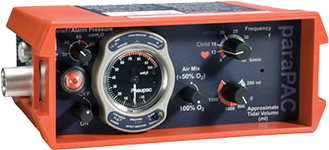
Ventilation
- Adjust settings (may be based on existing Ventilator settings or anticipated patient needs).
- Relief pressure is maximum delivered pressure.
- Air mix is set at either "No Air Mix (100% Oxygen)" or "Air Mix (45% Oxygen).
- Frequency is the breaths per minute.
- Tidal volume is the volume of air per breath.
- Connect supply hose to Oxygen, turn on Oxygen, and check visual alarm.
- Connect patient hose and patient valve to ETT.
- Confirm ventilation with auscultation and Capnography. Confirm oxygenation with pulsoximeter.
- Constant patient monitoring is made more critical if Ventilator is in demand mode.
- Consider NG/OG Suction.
O-Two Ventilator Procedures
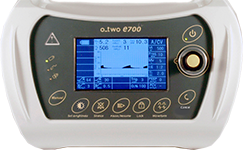
Circuit Layout
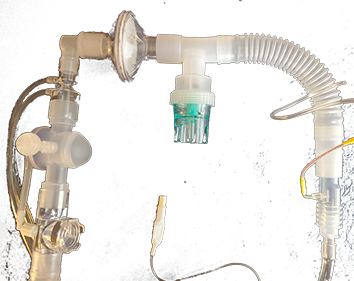
| Ventilator |
Elbow |
Filter |
Optional |
EtCO2 |
Patient |
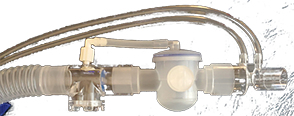 |
 |
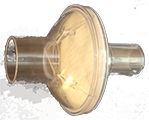 |
see optional below |
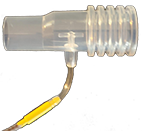 |
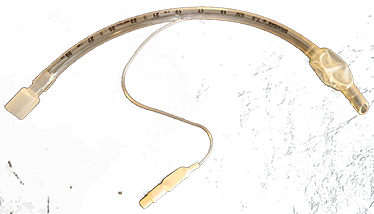 |
| Optional |
| Nebulizer |
Spacer |
Adapter (Jesus Piece) |
 |
 |
 |
Modes of Operation
| Patient Description |
Procedure |
| Cardiac Arrest |
| Mode |
CPR |
| Set PEEP |
0 cm H2O |
| Set Trigger |
- (none) |
| Set PMax |
60 cm H2O |
| ROSC |
After ROSC, refer to RSI settings below. |
|
| Pulmonary Edema (CPAP/BiPAP) |
| Mode |
CPAP or CPAP with PSV (same as BiPAP, do not use BiLVL) |
| Adjust CPAP (expiratory support) |
5-15 cm H2O |
| Adjust PSV (inspiratory support) |
0-15 cm H2O |
| Adjust Trigger |
P (patient) |
|
| Pulmonary Edema (intubated) |
| Mode |
A/CV |
| Set Vt (tidal volume) |
See tables below |
| Set BPM (rate) |
Titrate to EtCO2 and patient comfort:
- Infant: 20-40 BPM
- Child: 12-25 BPM
- Adult: 10-20 BPM
|
| Set PEEP |
10-24 cm H2O |
| Adjust Waveform |
Use FLOW waveform to see if breath stacking or spontanious breathing. |
| Sedation and Paralysis |
Refer to Protocol 2-044 - Airway: RSI for continued sedation and paralysis during the transport. |
|
| Patient Description |
Procedure |
| RSI or DSI |
| Mode |
A/CV |
| Set Vt (tidal volume) |
See tables below |
| Set BPM (rate) |
Titrate to EtCO2:
- Infant: 20-40 BPM
- Child: 12-25 BPM
- Adult: 10-20 BPM
|
| Set PEEP |
5-15 cm H2O (refer to Pulmonary Edema above, if applicable) |
| Adjust I:E ratio |
Longer exhalation to prevent air-trapping (i.e. Asthma patients) (1:2 = normal) (1:4 = long exhalation) |
| Adjust Ti (inspiration time) |
0.8-1.0 seconds |
| Adjust Waveform |
Use FLOW waveform to see if breath stacking or spontanious breathing. |
|
| Transfer (COVID) |
| Mode |
A/CV |
| Set Vt (tidal volume) |
See tables below |
| Set BPM (rate) |
Copy from RT ventilator ORTitrate to EtCO2 and patient comfort:
- Infant: 20-40 BPM
- Child: 12-25 BPM
- Adult: 10-20 BPM
|
| Set PEEP |
Adjust PEEP to match FiO2 and PEEP goals:
| PEEP goal |
60% FiO2 |
100% FiO2 |
| lower PEEP |
10 cm H2O |
18-24 cm H2O |
| higher PEEP |
20 cm H2O |
22-24 cm H2O |
|
| Adjust Ti (inspiration time) |
0.8-1.0 seconds |
| Adjust Waveform |
Use FLOW waveform to see if breath stacking or spontanious breathing. |
| Sedation |
Ensure patient is fully sedated prior to movement to ambulance cot. Refer to Protocol 2-924 - Universal Patient Care for Ketamine dosage. #sedatewhatyouintubate |
| Paralysis |
Refer to Protocol 2-044 - Airway: RSI for continued sedation and paralysis during the transport. |
|
| Patient Description |
Procedure |
| Transfer (non-COVID) |
|
Tidal Volume Based on Ulnar Length
Start with the middle tidal volume (in Bold) and adjust up or down within the range indicated.
| Ulnar Length |
Female(less than 65 yr old) |
Female(greater than 65 yr old) |
Male(less than 65 yr old) |
Male(greater than 65 yr old) |
| 19 cm |
290 (240-330) ml |
250 (210-290) ml |
320 (270-370) ml |
300 (250-350) ml |
| 20 cm |
300 (250-350) ml |
270 (230-310) ml |
350 (300-400) ml |
330 (280-390) ml |
| 21 cm |
320 (270-370) ml |
290 (240-330) ml |
350 (300-400) ml |
350 (300-400) ml |
| 22 cm |
340 (280-390) ml |
320 (270-370) ml |
400 (300-450) ml |
350 (300-450) ml |
| 23 cm |
350 (300-450) ml |
350 (250-400) ml |
400 (350-500) ml |
340 (280-390) ml |
| 24 cm |
400 (300-450) ml |
350 (300-450) ml |
450 (350-500) ml |
400 (350-500) ml |
| 25 cm |
400 (300-500) ml |
350 (300-450) ml |
450 (350-550) ml |
450 (350-500) ml |
| 26 cm |
400 (350-500) ml |
400 (300-500) ml |
500 (400-550) ml |
450 (350-550) ml |
| 27 cm |
450 (350-500) ml |
400 (350-500) ml |
500 (400-600) ml |
450 (350-550) ml |
| 28 cm |
450 (350-550) ml |
450 (350-500) ml |
550 (450-650) ml |
500 (400-600) ml |
| 29 cm |
450 (350-550) ml |
450 (350-550) ml |
550 (450-650) ml |
500 (400-600) ml |
| 30 cm |
500 (400-550) ml |
500 (400-550) ml |
600 (450-700) ml |
550 (450-650) ml |
| 31 cm |
500 (400-600) ml |
500 (400-600) ml |
600 (500-700) ml |
550 (450-650) ml |
| 32 cm |
500 (400-600) ml |
500 (400-600) ml |
600 (500-700) ml |
600 (450-700) ml |
Tidal Volume Based on IDEAL Body Weight (7 ml/kg)
Start with the middle tidal volume (in Bold) and adjust up or down within the range indicated.
| Height |
Pediatric |
Adult Female |
Adult Male |
| Weight | Tidal Volume |
Weight | Tidal Volume |
Weight | Tidal Volume |
| Preemie (Broslow: Grey) |
2 kg | 15 (10-20) ml |
| |
| |
| Newborn (Broslow: Grey) |
4 kg | 30 (20-35) ml |
| |
| |
| 4 mo old (Broslow: Pink) |
6 kg | 40 (30-50) ml |
| |
| |
| 6 mo old (Broslow: Red) |
8 kg | 60 (40-70) ml |
| |
| |
| 1 yr old (Broslow: Purple) |
10 kg | 70 (60-80) ml |
| |
| |
| 2 yr old (Broslow: Yellow) |
12 kg | 80 (70-100) ml |
| |
| |
| 3 yr old (Broslow: White) |
14 kg | 100 (80-120) ml |
| |
| |
| 4 yr old (Broslow: White) |
16 kg | 110 (90-130) ml |
| |
| |
| 4 yr old (Broslow: White) |
18 kg | 130 (100-150) ml |
| |
| |
| 5 yr old (Broslow: Blue) |
20 kg | 140 (120-160) ml |
| |
| |
| 6 yr old (Broslow: Blue) |
22 kg | 150 (130-180) ml |
| |
| |
| 7 yr old< (Broslow: Orange) |
24 kg | 170 (140-200) ml |
| |
| |
| 7 yr old< (Broslow: Orange) |
26 kg | 180 (150-210) ml |
| |
| |
| 8 yr old (Broslow: Orange) |
28 kg | 200 (160-230) ml |
| |
| |
| 9 yr old (Broslow: Green) |
30 kg | 210 (180-240) ml |
| |
| |
| 9 yr old (Broslow: Green) |
32 kg | 220 (190-260) ml |
| |
| |
| 10 yr old (Broslow: Green) |
34 kg | 240 (200-280) ml |
| |
| |
| 10 yr old< (Broslow: Green) |
36 kg | 250 (210-290) ml |
| |
| |
| 11 yr old (Broslow: Green) |
38 kg | 270 (220-310) ml |
| |
| |
| 11 yr old (Broslow: Green) |
40 kg | 280 (240-320) ml |
| |
| |
| 11 yr old (Broslow: Green) |
42 kg | 290 (250-340) ml |
| |
| |
| 4'-8" |
| |
36 kg | 250 (210-290) ml |
| |
| 4'-10" |
| |
41 kg | 290 (240-330) ml |
45 kg | 320 (270-370) ml |
| 5'-0" |
| |
46 kg | 320 (270-370) ml |
50 kg | 350 (300-400) ml |
| 5'-2" |
| |
50 kg | 350 (300-450) ml |
55 kg | 400 (300-450) ml |
| 5'-4" |
| |
55 kg | 400 (300-450) ml |
59 kg | 400 (350-500) ml |
| 5'-6" |
| |
59 kg | 400 (350-500) ml |
64 kg | 450 (350-550) ml |
| 5'-8" |
| |
64 kg | 450 (350-550) ml |
68 kg | 500 (400-550) ml |
| 5'-10" |
| |
69 kg | 500 (400-550) ml |
73 kg | 500 (400-600) ml |
| 6'-0" |
| |
73 kg | 500 (400-600) ml |
78 kg | 550 (450-650) ml |
| 6'-2" |
| |
78 kg | 550 (450-650) ml |
82 kg | 600 (450-700) ml |
| 6'-4" |
| |
82 kg | 600 (450-700) ml |
87 kg | 600 (500-700) ml |
| 6'-6" |
| |
87 kg | 600 (500-700) ml |
91 kg | 650 (500-750) ml |
| 6'-8" |
| |
92 kg | 650 (500-750) ml |
96 kg | 650 (550-800) ml |
| 6'-10" |
| |
| |
101 kg | 700 (600-850) ml |
Troubleshooting
General Guidelines:
- Remember to click twice when changing settings. #dontgettrickedjustclick
- Use 60% FiO2 whenever the patient condition allows.
- Ventilator takes approximately 8-10 breaths or 30 seconds to meet settings entered.
- Set P-Max 10 cm H20 above Paw (peak airway pressure).
P-Max alarm above 35 cm H2O: Stiff lung.
Dislodged: Check EtCO2, lung sounds, epigastium, SpO2.
Obstructed: Check suction need, kinked tubing, SpO2, EtCO2.
Pneumothorax: Check lung sounds, blood pressure, SpO2.
Equipment: Check cuff inflation, circuit connections.
Citations:
- Protocol 9-010 - References
- Flynn, 2020.
- Mercy, 2014.
- Miller, 2020.
- National Institutes of Health, 2020.
- O-Two Medical Technologies, Inc., 2017.
- OKeefe, 2020.
- Snyder, 2018.
Change Log:
| Date | Link topreviousversion | Description of change |
|---|
| 12/15/13 | pdf | Changed to BLS skill. |
| 01/29/14 | | Changed back to ALS skill. |
| 12/29/14 | pdf | Added this protocol from 8-270 (ParaPac Ventilator) and removed 8-270. |
| 07/04/20 | | Renumbered the section to allow for future additions. |
| 08/08/20 | pdf | Added content (without substantive modification) from old Section 8-330 - Portable Ventilator. |
| 10/05/20 | | Significant additions for O-Two ventilator with input from Mercy LifeLine Protocols. |
| 10/09/20 | | Significant additions for O-Two ventilator with input from Bobby OKeefeCox Air Care Protocols. |
| 10/27/20 | pdf | Updates to settings based on conversations with CMH Respiratory TherapyHospitalists. Switched from SIMV to A/CV. Also added content from ARDSnet. |
| 11/06/20 | pdf | Added comments from Dr. Nicholes about ensuring continued paralysis if Ketamine is not enough. |
| 11/09/20 | pdf | Approved by Dr. Nicholes |
| 06/15/21 | pdf | Moved to emsprotocols.online |
| CMH Pre-Hospital Services Mission: "Provide safe, exceptional, and compassionate care to our communities with an emphasis on highly trained and empowered staff." |
CMH Mobile Integrated Healthcare Mission: "Provide exceptional, compassionate, and patient-centered care by a mobile collaborative team to improve patient experience, improve quality outcomes, and reduce healthcare costs." |

|
















